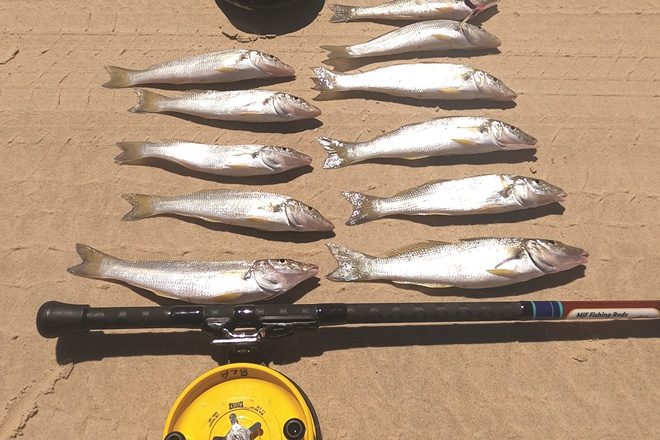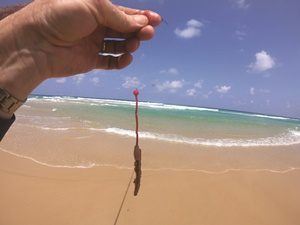
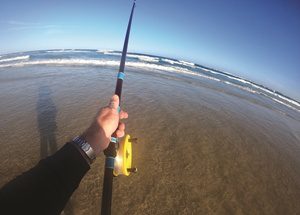
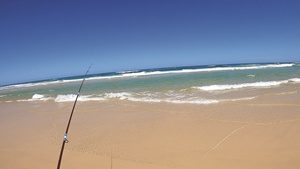
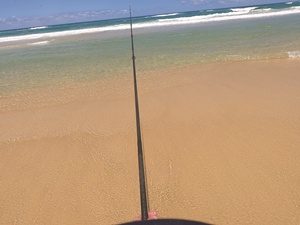
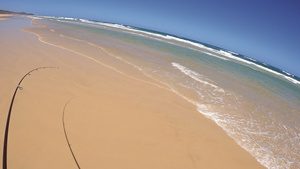
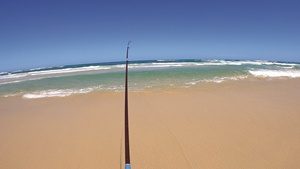
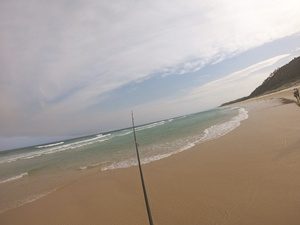
WITH summer now in full swing, what better time to chase some summer whiting from the beach in Queensland and northern NSW. Although they can be caught all year around, particularly in southeast Queensland, summer or yellowfin whiting are a great option from the beach in summer, particularly when other beach targets like tailor and bream are in thinner numbers.
Not the dart!
For many anglers, including me, there is nothing worse than going to all the trouble of catching your own beach or bloodworms (or paying for them) to have them snatched by bait-stealing dart! While you can’t avoid them altogether, this article focuses on catching beach whiting while at the same time avoiding big dart. Low tide whiting
Big dart tend to prefer to forage for food and seek shelter in deeper gutters, the sort you might often associate tailor with. Likewise, high tide will fill a lot of smaller gutters close to shore and bring bigger dart in. Big dart also don’t seem to mind the fast rush of the rising tide, unlike whiting that prefer the calmer, cleaner gutters.
For this reason, low tide can be an excellent time to chase whiting off the beach, remembering there are a number of other factors at play to help ensure you get a feed. This isn’t to say you can’t catch whiting at high tide on the beach, in fact shallow, calm shore dump gutters in a small swell are sometimes a good option. But after many years trying, I’ve come to favour low tide on the beach for whiting, particularly when the swell and sweep is too fast on the high tide.Low tide whiting
The right conditions
Before we focus on the type of water you want to target at low tide, it’s worth noting the conditions that best suit low tide whiting fishing. Winds and swell can play a big part on your success on the beach. Too much wind and swell and your gutters can turn into a washing machine and the fish will disappear, seeking calmer water.Low tide whiting
Whiting are a small foraging fish that doesn’t like too much wave action or stirred sand, as this will push them around. Another consideration is weed, and infestations can shut beach fishing down completely. Sadly, red weed blooms occur in climatic cycles and can inundate southeast Queensland beaches such as Fraser Island, Rainbow and Teewah beaches when the water temperature conditions are right.
This has happened again this year. North-northeast winds will blow this weed in while southeast and westerly winds will blow it back out. But setting aside the weed, slight to moderate southeast winds can be great for whiting, creating enough cover for the fish in the form of ripples, yet leaving clean water for the fish to feed in.Low tide whiting
Gutter formations
So what are good low tide gutter formations? I probably have two favourite gutter types that I like to target for whiting on the low tide. The first is blind end gutters. These have a closed end right on the beach where the whiting will hold up in.
They also have a shallow gutter of up to 0.5-1m or so deep with a back sandbank running off behind it at right angles to an entry out to deeper water. The tactic in these gutters is to stand well back from the water’s edge and cast up and into the blind end or corner and allow your bait to sit. The other option is to cast up and onto the back sandbank and slowly retrieve your bait into the gutter and towards the shore to find where the fish are.
The other great low tide gutter formation is a shallow drain or gutter running very close to shore. These are best if they still have enough water for a north and south entry and exit point and have sufficient water washing over the rear sandbank to occasionally wash a cover of white water over the gutter.Low tide whiting
Once again, the best way to fish these is to stand well back from the edge so you don’t spook the fish. To find the fish, a good option is to lob your bait to sit just behind the shore break where the fish might be feeding on dislodged pipis and worms, or cast up to the back bank and slow retrieve your bait into the gutter before letting it sit in the gutter for cruising fish to find it.
Other considerations
While many people associate whiting with the daytime, they can also be a great target at night off the beach, and again the same sort of formations as above are good on low tide. Another factor that can help draw fish to the gutter and keep them there is the rare art of berleying on the beach.
This can be as simple as worming in front of the gutter you plan to fish (with your stink bag smell and loose tidbits breaking off and attracting the fish) or tossing either pre-mixed berley or old bait like worms into a calm gutter with very little sweep.Low tide whiting
Tackle and bait
When it comes to reels, there is no better or sturdier reel than the Alvey side cast for the beach. The bigger diameter also means you can cast further when required and the direct wind keeps you in contact with the fish. Likewise, the ability to wind backwards to give a timid fish some line is another huge advantage of the Alvey.
I like to match 5-5.5”Alveys with a 10’6” or so long, light whippy rod. One-piece rods will certainly give you a better action and bend if you have the ability to transport them to your location. I also like to use Platypus Super 100 monofilament line for my mainline in 6lb due to its ultra-thin diameter.
This not only means it’s harder for the fish to see, but is also less susceptible to drag compared to heavier, thicker lines. I will then run a metre of 6lb fluorocarbon trace to a size 4 Tru-Turn 860 Blue Aberdeen hook due to their unique offset cam designed to force the point of the hook up to grab a solid hold in the fish’s mouth.Low tide whiting
A short length of red bead or tubing in front of the hook also attracts the fish to the bait. When using an Alvey reel, also be sure to run a swivel around size 12 as the last item in your rig to avoid line twist. This means you want to run your sinker between two swivels with a soft green bead above the bottom swivel to avoid the sinker breaking the knot during casting.
When it comes to bait, live beachworms or bloodworms are the best baits, followed by yabbies and pipis. Finally, particularly if you berley the gutter or are worming in front of it, keep an eye out for the black shadows of fish patrolling the edge of the gutter or following the waves up the beach. You can then try and sight cast to them, though this is easier said than done!Low tide whiting
I hope these tips and the attached videos help you land a few whiting from low tide gutters at your favourite beach this summer. For more tips and tricks, please jump on and like my Facebook page Ontour Fishing Australia.
To watch a video explaining the points above click here.
 Bush ‘n Beach Fishing Magazine Location reports & tips for fishing, boating, camping, kayaking, 4WDing in Queensland and Northern NSW
Bush ‘n Beach Fishing Magazine Location reports & tips for fishing, boating, camping, kayaking, 4WDing in Queensland and Northern NSW

